The mystery of a hole in the "Union"
The morning of August 30 was not very kind for the crew of the ISS. An air leak from the station was detected, so the astronauts and astronauts had to search for the leak and repair it. The hole was found in the household compartment of Soyuz MS-09, and, despite the fact that it had already been successfully patched, disputes about its possible cause did not subside on the Internet. Is this an ordinary blow of micrometeorite or space junk?

"Union MS-09" (left), docked to the ISS, photo by NASA
Atmospheric leakage was detected on the night of August 30th. The ISS has a permissible leakage level of 0.5 millimeters of mercury per hour (there are no perfectly tight connections), but from about 18 hours UTC (21 MSK) it increased to 0.8 mm, and overnight rose to 4 mm Hg. Art. at one o'clock. The fact that the leak was not a serious danger is indicated by at least the fact that the astronauts did not immediately wake up. But, of course, upon awakening, the problem had to be addressed. First of all, it was necessary to establish the place of the hole. To do this, they began to block the compartments of the ISS - where the pressure drops, there is a leak. It was quickly determined that there was a hole in the domestic compartment of the Soyuz MS-09 spacecraft, which had docked with the ISS on June 8. To accurately determine the location of the leak at the station there is an ultrasonic leak detector - a tool capable of detecting high-frequency whistles of outgoing air.

Ultrasonic leak detector, slide from NASA presentation
')
Household compartment of the ship "Soyuz" has a spherical shape. It houses a docking station, some ship systems, in particular, a toilet, but, most importantly, what it gives is extra space. The descent vehicle is quite close, and it would be uncomfortable to be in it for two days from start to docking. The household compartment and the instrument-unit compartment are separated from the descent vehicle and burned in the atmosphere during landing.

The scheme of the ship "Soyuz", the image of Roscosmos
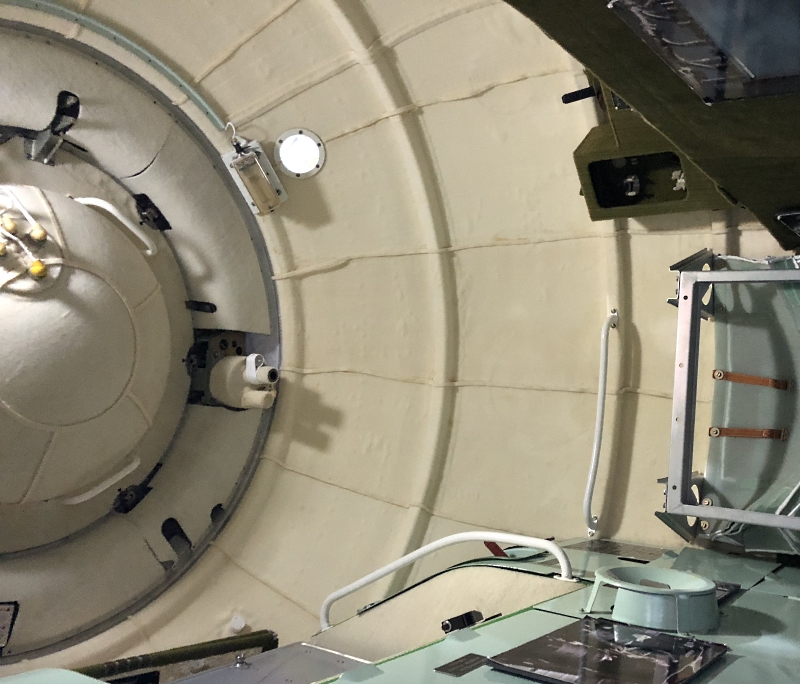
Household compartment from the inside, photo by John McGauley / NasaSpaceFlight forum
At this stage, there was some confusion - first, two holes were reported in the media, but in the end it turned out to be one, with a diameter of about 2 millimeters. The hole was located on the wall of the domestic compartment near the frame under the upholstery, which had to bend. Nothing threatened the safety of people - according to the MCC calculations, it would take 18 days to lose the atmosphere of the ISS. So the hole was temporarily sealed with Kapton tape and they began to think about how best to seal it on a permanent basis. The fact that the astronauts were sent to lunch, while the Central Control Unit of Moscow was thinking about how to plug the hole, said that there was no danger.
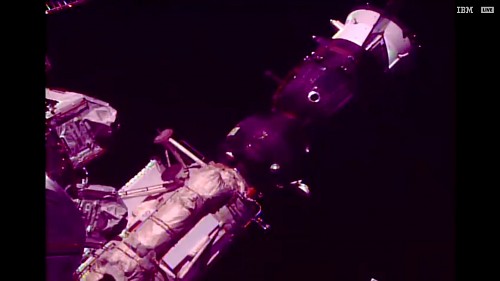
"Union MS-09", docked to the ISS, a frame from the broadcast NASA TV
What was happening could be viewed live on NASA TV, but, unfortunately, photographs of the detected holes were not published there and appeared much later, and only two.
Further, some disagreements arose between the Russian cosmonauts and the American astronauts. TsUPU Moscow offered to seal the hole immediately, and the commander of the ISS Andrew J. Feistel offered to take a day to learn how to plug holes and then do it once, but definitely fine. Some time was spent on communication between the MCCs of Moscow and Houston, and this story became a rare case when disagreements between countries working on the ISS surfaced in a public space. In the end, after all the negotiations, the Russian plan for an immediate leakage was adopted.
In order to close the hole, the fabric patch was soaked with vacuum-resistant epoxy resin and pushed into the hole. It was not enough one layer - on a surface swelling was formed. After a short wait, another epoxy-impregnated layer was applied. Some time later, the protruding parts of the patch were cut. The pressure at the station was monitored for at least 24 hours, and to facilitate diagnosis, the temperature on the ISS was fixed at the same level, no signs of pressure drop were found, so the problem was finally eliminated. The leak was detected at approximately 14:00 UTC and was fixed at approximately 4:30 pm UTC.
The photographs that appeared the next day gave rise to the main mystery of the story - what is the origin of the hole?
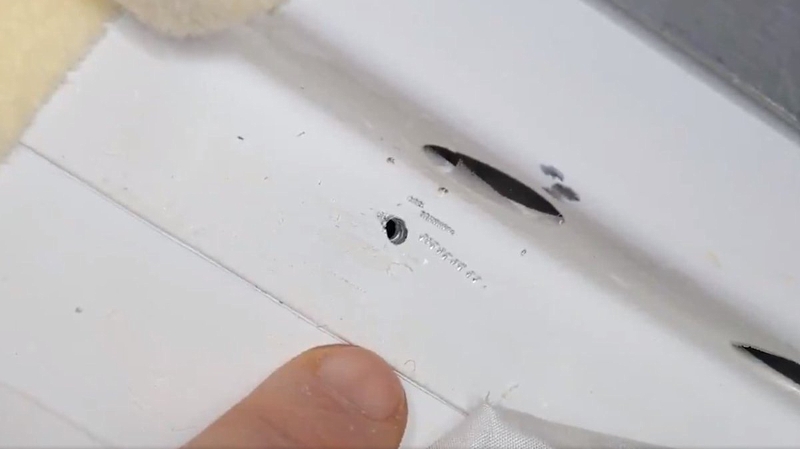
Hole before sealing, photo by NASA
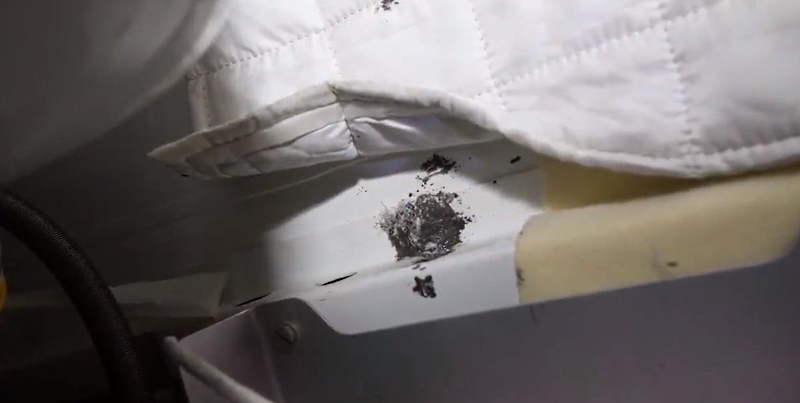
And after
The official version is a common encounter with micrometeorite or space junk. Such events occur regularly, because the space control systems have a sensitivity limit, and a particle hit below this limit causes quite noticeable damage. Over the twenty years of operation of the ISS, its modules bear traces of dozens of strikes.

Traces of micrometeorite strikes on the Zvezda service module, NASA photo
The problem with this version is that the hole looks like a hole drilled or punched, but not like a trail from a meteorite strike. In addition to photographs, in the broadcast dialogs, the astronauts themselves described it as “similar to drilled”. And even you can see traces similar to unsuccessful attempts to drill. Let's look at possible versions in more detail:
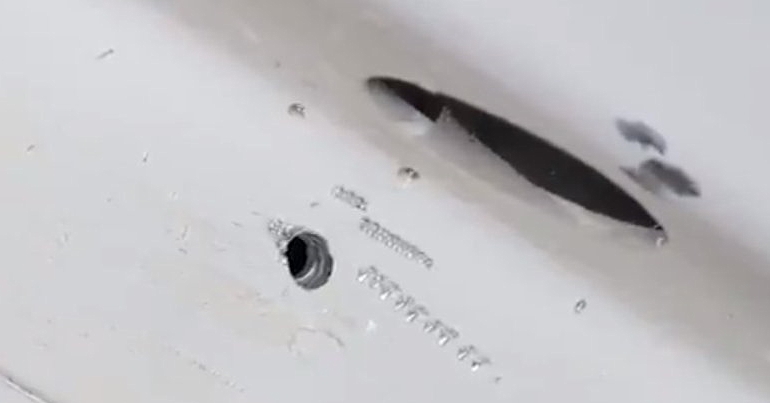
Hole close up
Version 1. Micrometeorite / space debris strike
Arguments for":
Arguments against":
Version 2. A hole drilled in the production. For example, during the production / assembly of a ship, a worker drilled a hole in the wrong place, and air began to flow out of it. But this version has many problems of its own.
Arguments for":
Arguments against":
Version 3. The astronauts drilled a hole during the repair, but in the broadcast it did not leave any traces.
Arguments for":
Arguments against":
Personally, in my opinion, under the conditions of the available information, the version of the impact of a micrometeorite looks most plausible - it does not require complex and unlikely constructions. But this assumption is not enough for an unequivocal information output. For example, no photos of the external side of the hole appeared in open access. But the sofa guessing of the causes of incidents is good for that - it gives the brain a warm-up and the opportunity to learn new things.
UPD: Rumors appeared with links to a “source in the industry” in favor of the second version. There is no trust so far because it happened that the discussions from the forum of the magazine “Cosmonautics News” were presented as opinions of sources from the industry. And serious arguments against this version do not disappear anywhere - there are no cork marks on the photo, and an attempt to seal the hole should have left them, look at the photo after the repair. And it is strange that very high vibration loads at the start with the cork did not do anything, and they squeezed out two months in space without any special overloads.
UPD2: The version with a meteorite is officially shallow, now they understand who drilled the Soyuz and when. On Monday, Dmitry Rogozin made a statement:

"Union MS-09" (left), docked to the ISS, photo by NASA
Chronology of events
Atmospheric leakage was detected on the night of August 30th. The ISS has a permissible leakage level of 0.5 millimeters of mercury per hour (there are no perfectly tight connections), but from about 18 hours UTC (21 MSK) it increased to 0.8 mm, and overnight rose to 4 mm Hg. Art. at one o'clock. The fact that the leak was not a serious danger is indicated by at least the fact that the astronauts did not immediately wake up. But, of course, upon awakening, the problem had to be addressed. First of all, it was necessary to establish the place of the hole. To do this, they began to block the compartments of the ISS - where the pressure drops, there is a leak. It was quickly determined that there was a hole in the domestic compartment of the Soyuz MS-09 spacecraft, which had docked with the ISS on June 8. To accurately determine the location of the leak at the station there is an ultrasonic leak detector - a tool capable of detecting high-frequency whistles of outgoing air.

Ultrasonic leak detector, slide from NASA presentation
')
Household compartment of the ship "Soyuz" has a spherical shape. It houses a docking station, some ship systems, in particular, a toilet, but, most importantly, what it gives is extra space. The descent vehicle is quite close, and it would be uncomfortable to be in it for two days from start to docking. The household compartment and the instrument-unit compartment are separated from the descent vehicle and burned in the atmosphere during landing.

The scheme of the ship "Soyuz", the image of Roscosmos

Household compartment from the inside, photo by John McGauley / NasaSpaceFlight forum
At this stage, there was some confusion - first, two holes were reported in the media, but in the end it turned out to be one, with a diameter of about 2 millimeters. The hole was located on the wall of the domestic compartment near the frame under the upholstery, which had to bend. Nothing threatened the safety of people - according to the MCC calculations, it would take 18 days to lose the atmosphere of the ISS. So the hole was temporarily sealed with Kapton tape and they began to think about how best to seal it on a permanent basis. The fact that the astronauts were sent to lunch, while the Central Control Unit of Moscow was thinking about how to plug the hole, said that there was no danger.

"Union MS-09", docked to the ISS, a frame from the broadcast NASA TV
What was happening could be viewed live on NASA TV, but, unfortunately, photographs of the detected holes were not published there and appeared much later, and only two.
Further, some disagreements arose between the Russian cosmonauts and the American astronauts. TsUPU Moscow offered to seal the hole immediately, and the commander of the ISS Andrew J. Feistel offered to take a day to learn how to plug holes and then do it once, but definitely fine. Some time was spent on communication between the MCCs of Moscow and Houston, and this story became a rare case when disagreements between countries working on the ISS surfaced in a public space. In the end, after all the negotiations, the Russian plan for an immediate leakage was adopted.
In order to close the hole, the fabric patch was soaked with vacuum-resistant epoxy resin and pushed into the hole. It was not enough one layer - on a surface swelling was formed. After a short wait, another epoxy-impregnated layer was applied. Some time later, the protruding parts of the patch were cut. The pressure at the station was monitored for at least 24 hours, and to facilitate diagnosis, the temperature on the ISS was fixed at the same level, no signs of pressure drop were found, so the problem was finally eliminated. The leak was detected at approximately 14:00 UTC and was fixed at approximately 4:30 pm UTC.
Mysterious hole
The photographs that appeared the next day gave rise to the main mystery of the story - what is the origin of the hole?

Hole before sealing, photo by NASA

And after
The official version is a common encounter with micrometeorite or space junk. Such events occur regularly, because the space control systems have a sensitivity limit, and a particle hit below this limit causes quite noticeable damage. Over the twenty years of operation of the ISS, its modules bear traces of dozens of strikes.

Traces of micrometeorite strikes on the Zvezda service module, NASA photo
The problem with this version is that the hole looks like a hole drilled or punched, but not like a trail from a meteorite strike. In addition to photographs, in the broadcast dialogs, the astronauts themselves described it as “similar to drilled”. And even you can see traces similar to unsuccessful attempts to drill. Let's look at possible versions in more detail:

Hole close up
Version 1. Micrometeorite / space debris strike
Arguments for":
- Such blows happen regularly.
Arguments against":
- The hole does not look like a micrometeorite strike.
- The photo of the upholstery is not noticeable traces of what hit.
Version 2. A hole drilled in the production. For example, during the production / assembly of a ship, a worker drilled a hole in the wrong place, and air began to flow out of it. But this version has many problems of its own.
Arguments for":
- The hole is like drilled. Nearby you can find traces of what seems to be trying to drill.
Arguments against":
- Drilled through the hole would pass air immediately. This would have been noticed at the stage of preparing the ship for launch.
- The option “sealed something with a hole, then it fell off” is not confirmed by the absence of any traces.
- The greatest load for the ship was the launch site. Why the hole did not open when the "Union" vibrated from the engine?
- The night on the ISS is the quietest time, it is difficult to come up with some kind of sudden shake that would reveal the hole.
Version 3. The astronauts drilled a hole during the repair, but in the broadcast it did not leave any traces.
Arguments for":
- In the aviation and space industry, there really is an algorithm for crack patching with reaming of its ends. In this case, the stress of the material is removed, and the crack does not grow further.
Arguments against":
- Dozens, if not hundreds of people listened to the broadcast. No one noticed any trace of the planning and execution of these works, despite the fact that the actions of the crew and the recommendations of the MCC are described in great detail.
- Astronauts comment that the hole looks like a drilled, sounds in the broadcast almost immediately after its detection.
Personally, in my opinion, under the conditions of the available information, the version of the impact of a micrometeorite looks most plausible - it does not require complex and unlikely constructions. But this assumption is not enough for an unequivocal information output. For example, no photos of the external side of the hole appeared in open access. But the sofa guessing of the causes of incidents is good for that - it gives the brain a warm-up and the opportunity to learn new things.
UPD: Rumors appeared with links to a “source in the industry” in favor of the second version. There is no trust so far because it happened that the discussions from the forum of the magazine “Cosmonautics News” were presented as opinions of sources from the industry. And serious arguments against this version do not disappear anywhere - there are no cork marks on the photo, and an attempt to seal the hole should have left them, look at the photo after the repair. And it is strange that very high vibration loads at the start with the cork did not do anything, and they squeezed out two months in space without any special overloads.
UPD2: The version with a meteorite is officially shallow, now they understand who drilled the Soyuz and when. On Monday, Dmitry Rogozin made a statement:
True, the version of the meteorite is already shallowed, because a clear impact was on the skin of the ship from the inside
But once again I say, this is the version of the earth that is being checked, but there is also another version, which we also do not dismiss, a deliberate effect in space. There had to be an emphasis in order to make a hole in the right place. There are several attempts to impact the drill, then the failure of the drill, so a very interesting story, we find out
Source: https://habr.com/ru/post/422047/
All Articles